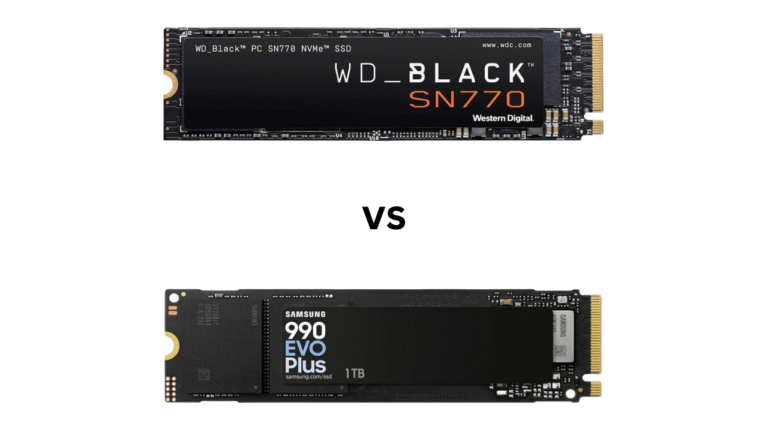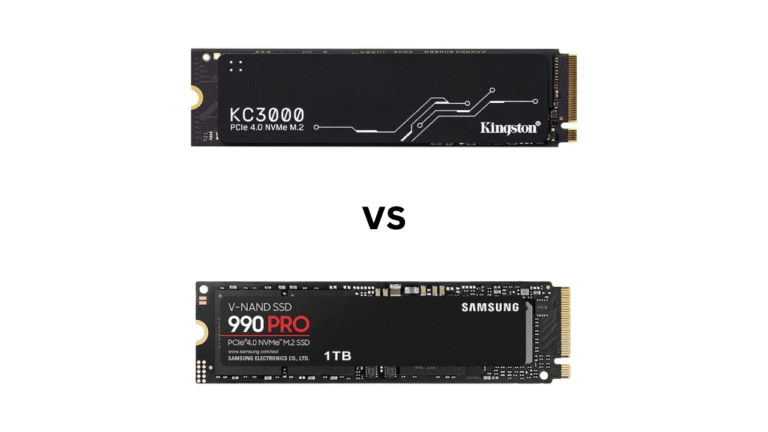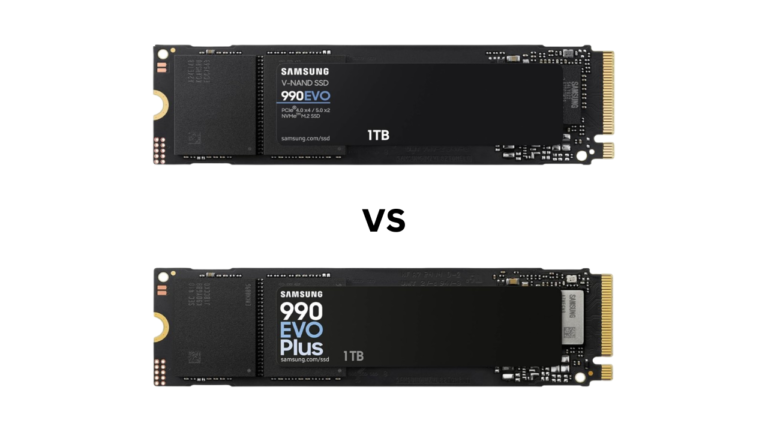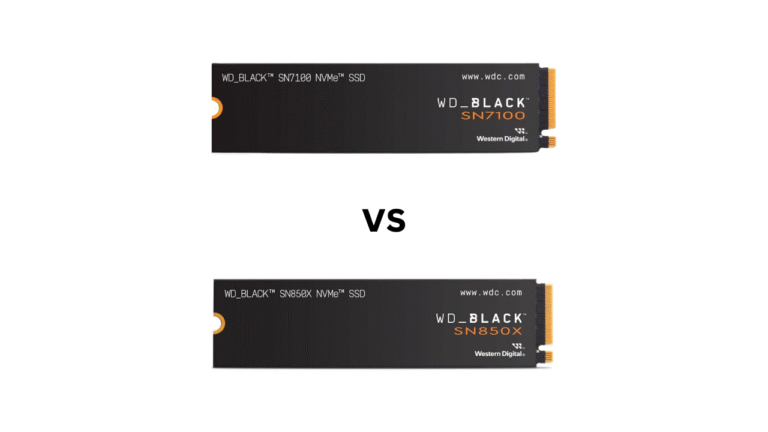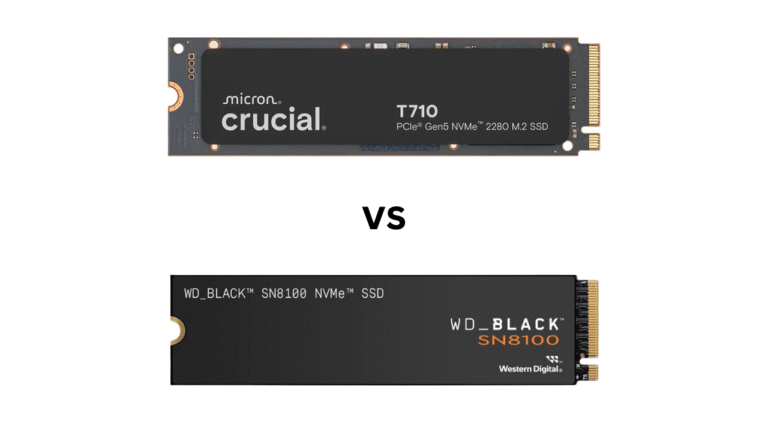Affiliate Disclosure: This post may include affiliate links. If you click and make a purchase, I may earn a small commission at no extra cost to you.
The Samsung 990 EVO Plus and WD Black SN7100 are both high-performance PCIe Gen 4 NVMe SSDs. The SN7100 is a full Gen 4.0×4, while the Samsung 990 EVO Plus also features Gen 5.0×2, along with Gen 4.0×4 lanes. Both drives come with the TLC NAND flash. Also, both are DRAM-less with a similar amount of HMB.
The 990 EVO Plus is equipped with Samsung V8-NAND, while the SN7100 has the BiCS8 NAND. Both the SSDs are in the mid-range NVMe category and have similar specifications. However, there are reasons to choose between the two. The WD Black SN7100 offers a 500GB variant for those seeking low storage space, whereas the 990 EVO Plus is available in 1TB, 2TB, and 4TB variants.
The SN7100 doesn’t have encryption, while the 990 EVO Plus is equipped with AES-256 and TCG Opal. Additionally, the Samsung 990 EVO Plus features a superior controller, specifically the Samsung Picollo, compared to WD’s Polaris 3.
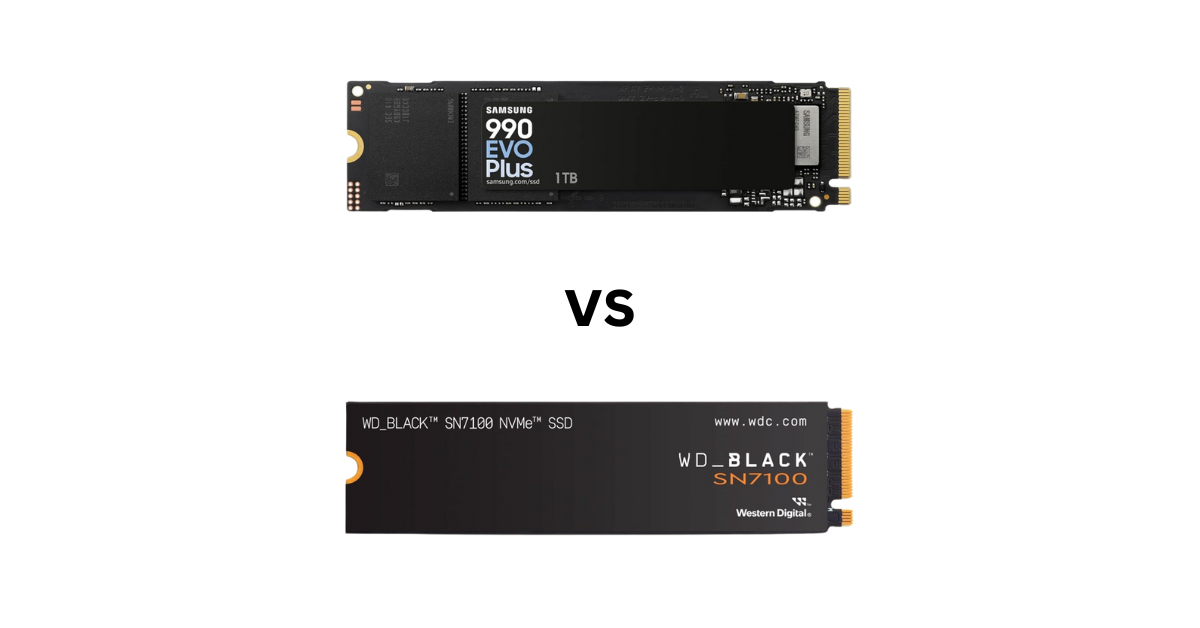
All in all, in my opinion, the 990 EVO Plus is a better choice in most cases, including in terms of price. However, the SN7100 can be suitable for raw read/write operations. However, the real performance differences will be seen in the benchmark comparison below.
Theoretical Specifications
| Specification | Samsung 990 EVO Plus | WD Black SN7100 |
|---|---|---|
| PCIe Generation/NVMe Version | PCIe Gen 4.0 x4 and 5.0 x2 / NVMe 2.0 | PCIe Gen 4.0 x4 / NVMe 2.0 |
| Release Date | Sep 25th, 2024 | Nov 21st, 2024 |
| Capacities | 1TB, 2TB, 4TB | 500GB, 1TB, 2TB, 4TB |
| NAND Flash | Samsung’s V8 V-NAND (236-layer) | Kioxia’s BiCS8 TLC rebranded as SanDisk 022644 2T00 4422D1JX403Q (218-Layer) |
| Sequential Read Speed | 1TB: 7,150 MB/s 2TB: 7,250 MB/s 4TB: 7,250 MB/s | 500GB: 6,800 MB/s 1TB: 7,250 MB/s 2TB: 7,250 MB/s 4TB: 7,000 MB/s |
| Sequential Write Speed | 1TB: 6,300 MB/s 2TB: 6,300 MB/s 4TB: 6,300 MB/s | 500GB: 5,800 MB/s 1TB: 6,900 MB/s 2TB: 6,900 MB/s 4TB: 6,700 MB/s |
| Random Read Speed | 1TB: 850K IOPS 2TB: 1,350K IOPS 4TB: 1,050K IOPS | 500GB: 760K IOPS 1TB: 1,000K IOPS 2TB: 1,000K IOPS 4TB: 900K IOPS |
| Random Write Speed | 1TB: 1,350K IOPS 2TB: 1,350K IOPS 4TB: 1,400K IOPS | 500GB: 1,200K IOPS 1TB: 1,400K IOPS 2TB: 1,400K IOPS 4TB: 1,350K IOPS |
| DRAM | None (HMB) | None (HMB) |
| Heatsink Option | No | No |
| Official Website | Samsung | SanDisk |
| Price | 1 TB starting at 59.99 | 500GB starting at $59.99 |
Samsung’s 990 EVO Plus features a unique dual-interface capability, supporting PCIe Gen 4.0 x4 and Gen 5.0 x2. This may attract forward-looking buyers seeking broader compatibility. However, both drives are DRAM-less and rely on Host Memory Buffer (HMB) for mapping.
Samsung utilizes its cutting-edge 236-layer V8 V-NAND, which delivers impressive sequential read speeds of up to 7,250 MB/s. At the same time, WD’s SN7100, leveraging Kioxia’s 218-layer BiCS8 TLC NAND, matches or slightly exceeds Samsung’s write performance at higher capacities, peaking at 6,900 MB/s versus Samsung’s 6,300 MB/s. In random IOPS, Samsung’s 2TB model dominates reads at 1,350K, but WD’s lineup holds a consistent advantage in random writes across most capacities. None of the SSDs includes a heatsink, so heat management can become necessary under heavy workloads.. Overall, Samsung emphasizes interface versatility and NAND density, whereas WD focuses on balanced performance and a wider range of sizes.
Benchmark Scores Comparison
Let’s compare the benchmark scores so that it becomes easier for you to reach the final decision based on the performance numbers. All the scores are for the 2TB variants of these SSDs.
PCMark 10 (Full Storage Benchmark)
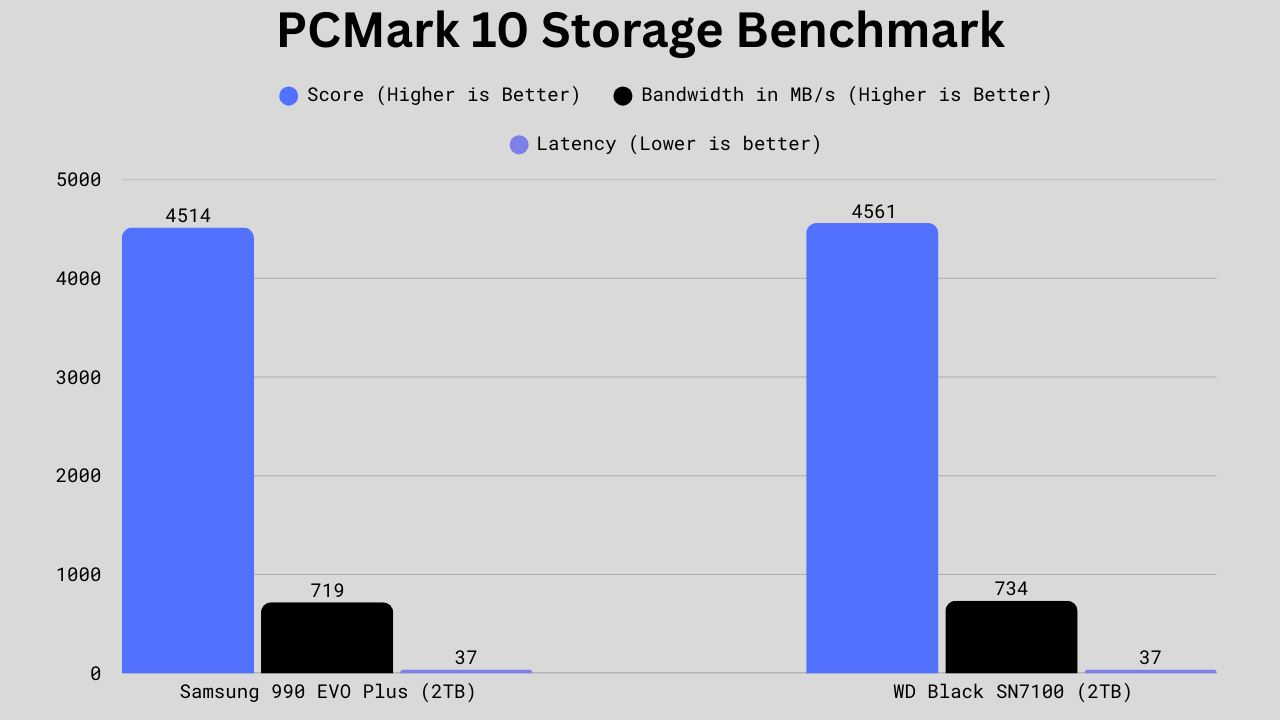
In PCMark 10, the WD Black SN7100 (2TB) scores 4561, approximately 1.04% higher than the Samsung 990 EVO Plus (2TB) at 4514, and delivers roughly 2.09% more bandwidth (734 MB/s vs. 719 MB/s), with identical latency at 37.0 µs. These margins are too small to matter in real-world use, so the performance difference between the two is effectively negligible. However, the SN7100 performs slightly better in both the overall score and bandwidth.
3DMark Storage Test for Gamers
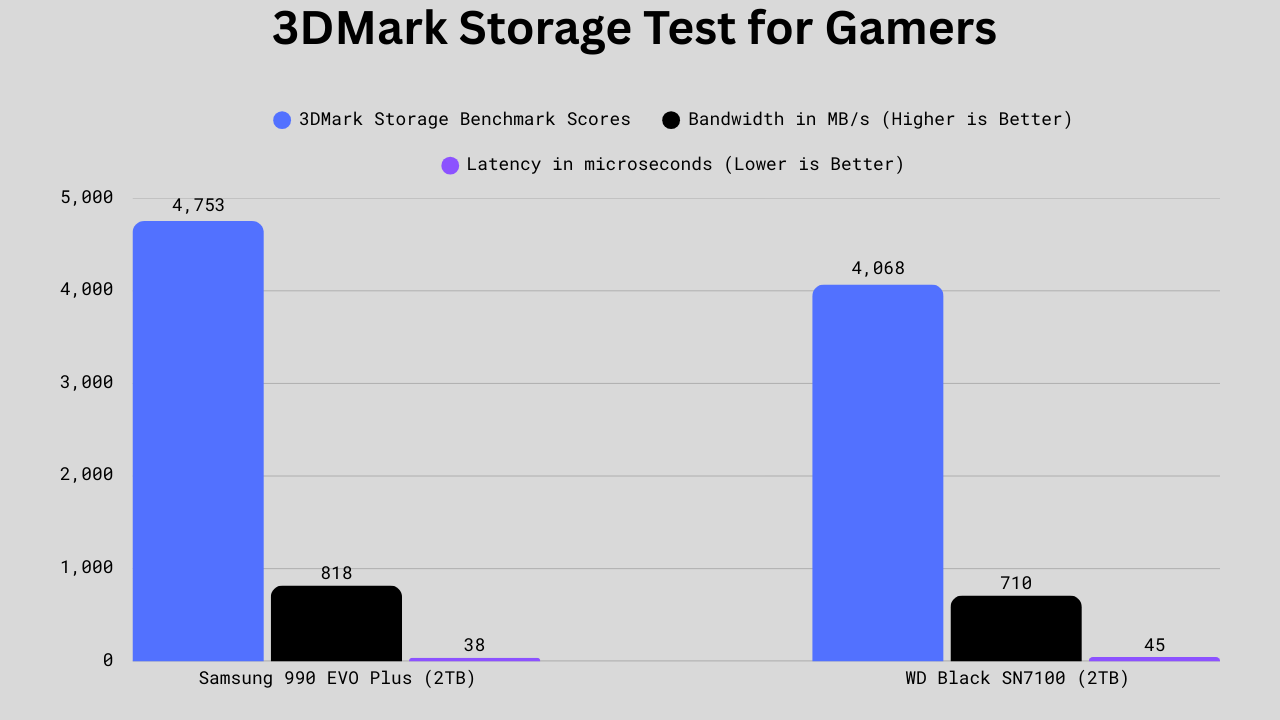
In the 3DMark Storage Benchmark, the Samsung 990 EVO Plus outpaces the WD Black SN7100. Samsung’s score of 4,753 is about 16.85% higher than WD’s 4,068, while its bandwidth of 818 MB/s is roughly 15.21% faster than WD’s 710 MB/s. Latency is also in Samsung’s favor, coming in at 38 µs versus WD’s 45 µs, a 15.56% improvement in responsiveness. These benchmark blips suggest that the Samsung 990 EVO Plus will handle game streaming, installing, extensive texture loading, and other heavy real-time storage tasks noticeably faster than the WD SN7100.
CrystalDiskMark Sequential Read/Write Speed
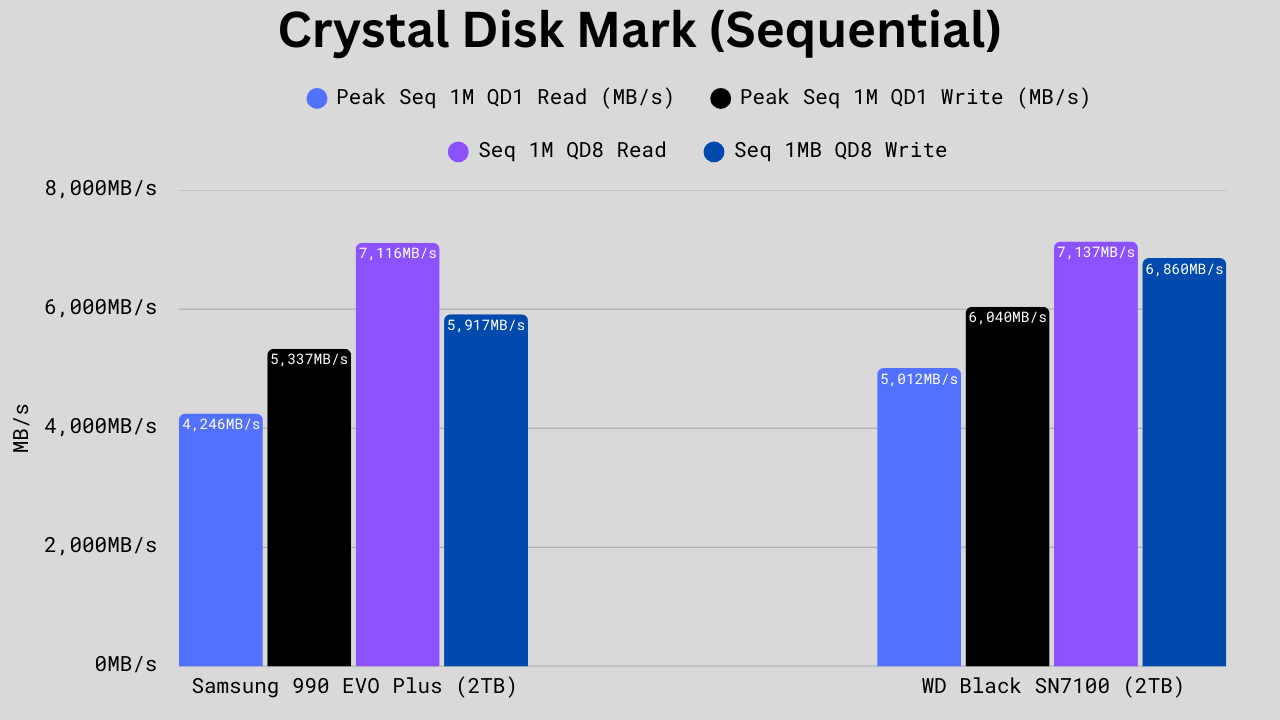
In sequential performance, the WD Black SN7100 consistently outperforms the Samsung 990 EVO Plus. For peak sequential QD1 reads, WD reaches 5,012 MB/s, about 18.05% faster than Samsung’s 4,246 MB/s. In QD1 writes, WD’s 6,040 MB/s is roughly 13.18% faster than Samsung’s 5,337 MB/s. At higher queue depths (QD8), reads are mainly tied, with 7,137 MB/s for WD versus 7,116 MB/s for Samsung (0.29% in WD’s favor). WD extends a large lead in QD8 writes, delivering 6,860 MB/s versus Samsung’s 5,917 MB/s, a 15.94% advantage. These results indicate SN7100 has stronger burst and sustained sequential performance, particularly in write-heavy scenarios, which could benefit large file transfers and media production workflows.
CrystalDiskMark Random Read/Write IOPS
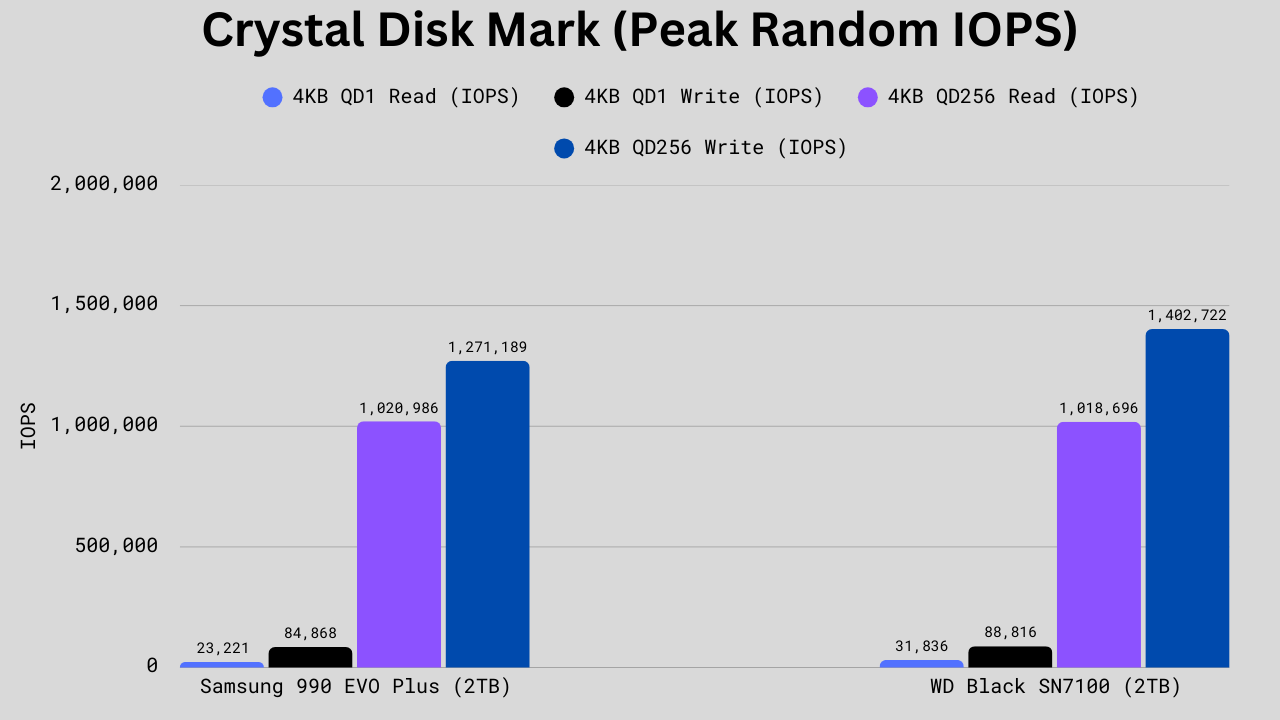
In 4KB QD1 (single-queue, single-thread) tests, the WD Black SN7100 pulls ahead in both reads and writes. Its 31,836 IOPS read speed is about 37.11% higher than the Samsung 990 EVO Plus’s 23,221 IOPS, and its 88,816 IOPS write speed is roughly 4.66% higher than Samsung’s 84,868 IOPS.
At high queue depths (QD256), reads are essentially tied, with Samsung at 1,020,986 IOPS and WD at 1,018,696 IOPS (a negligible 0.22% difference in Samsung’s favor). In high-QD writes, however, WD takes a more substantial lead—1,402,722 IOPS versus Samsung’s 1,271,189 IOPS, a 10.35% advantage. This means WD is better at low-queue and high-queue write operations, as well as single-thread reads, while Samsung holds a razor-thin edge only in extremely high-queue read scenarios. In practical terms, WD may feel slightly snappier for small random reads/writes in everyday multitasking and heavier write-intensive workloads.
Transfer Rate Benchmark
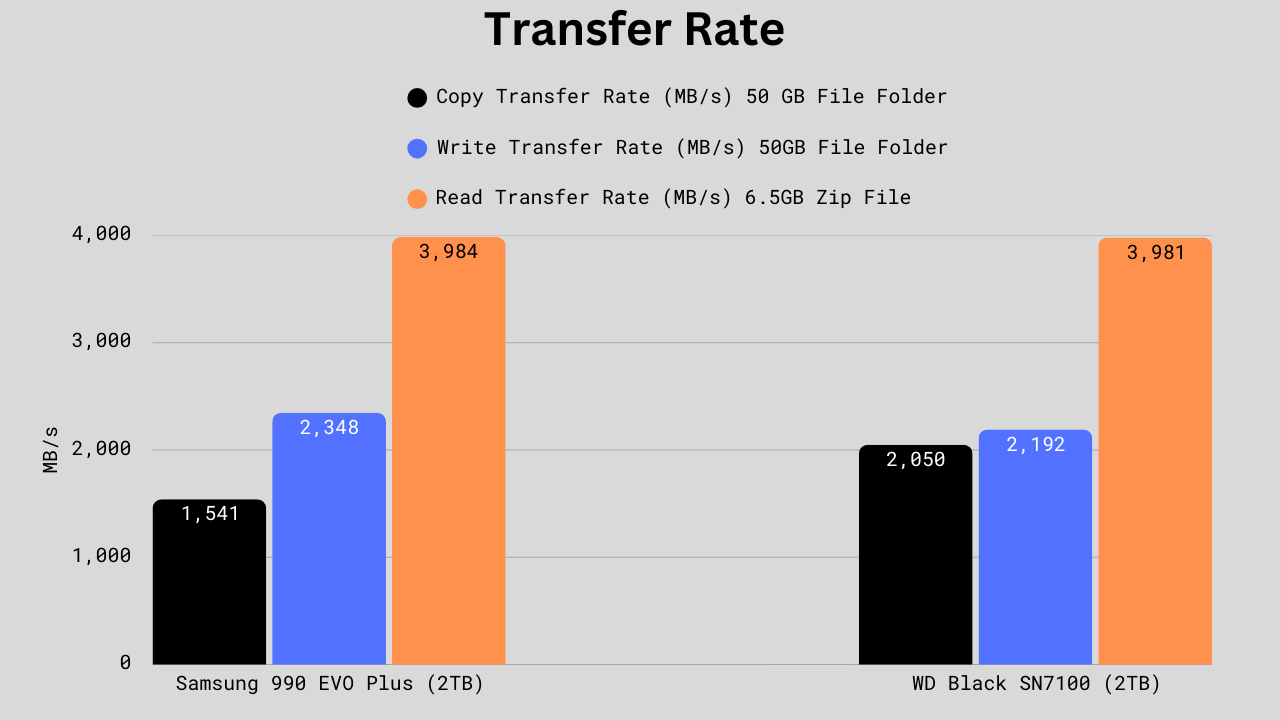
The WD Black SN7100 excels in copy operations with a 33% advantage over the Samsung 990 EVO Plus, making it ideal for users who frequently transfer large files or migrate data. However, Samsung takes the lead in write performance by 7%, which benefits content creators and users handling heavy write workloads. Read speeds are virtually identical between the two drives. Overall, the WD is better suited for mixed read/write tasks, such as file copying, while the Samsung edges ahead for pure write-intensive applications.
Power Consumption and Efficiency
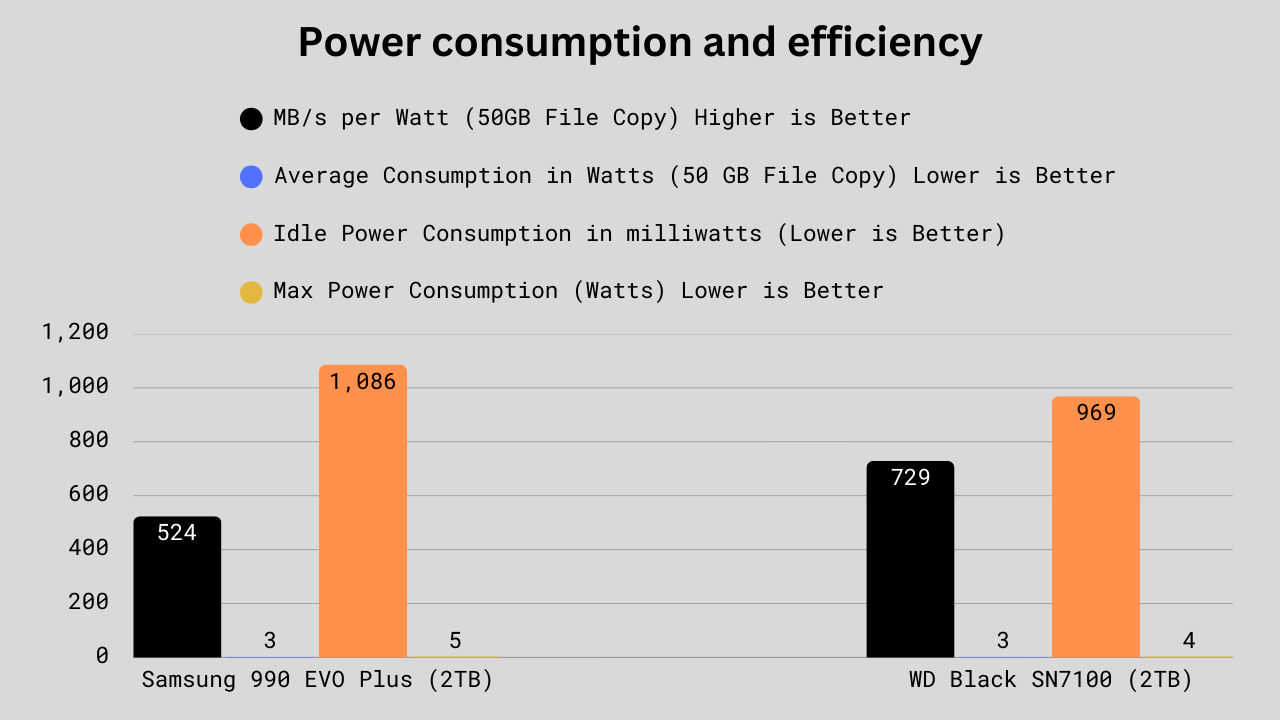
The WD Black SN7100 significantly outperforms the Samsung 990 EVO Plus in power efficiency metrics. The WD achieves 729 MB/s per watt, compared to Samsung’s 524 MB/s per watt, which is a substantial 39.1% advantage in efficiency.
Both drives consume the same 3 watts during active file copying operations, indicating equal power draw under load. However, the WD’s superior efficiency comes from its higher transfer rates achieved at the same power consumption level.
For idle power consumption, the WD Black SN7100 demonstrates better efficiency, at 969 milliwatts, compared to Samsung’s 1,086 milliwatts, which calculates to a 10.8% improvement in standby power consumption. This translates to longer battery life in laptops and lower overall system power draw when the drive isn’t actively being used.
Thermals
Based on comprehensive thermal testing from multiple independent sources, I found that the WD Black SN7100 significantly outperforms the Samsung 990 EVO Plus in thermal management. The WD reaches maximum temperatures of only 59-64°C under heavy loads compared to the Samsung’s 65-70°C, representing a 6-11°C temperature advantage. This superior thermal performance stems from the WD’s exceptional power efficiency, which consumes 10.8% less power at idle and delivers 39% better performance per watt. The WD’s cooler operation provides 26°C of thermal headroom before its 90°C throttling point. At the same time, Samsung operates closer to its thermal limits, making the WD the clear choice for laptops, compact systems, and any application where heat generation is a concern.
TBW, DWPD, and Warranty
| Specification | Samsung 990 EVO Plus | WD Black SN7100 |
|---|---|---|
| Endurance (TBW) | 1TB: 600 TBW 2TB: 1,200 TBW 4TB: 2,400 TBW | 500GB: 300 TBW 1TB: 600 TBW 2TB: 1,200 TBW 4TB: 2,400 TBW |
| Warranty | 5 Years | 5 Years |
| DWPD | 0.3 | 0.3 |
| MTBF | 1.5 Million Hours | Unknown |
All reliability specifications, including TBW, Warranty, and DWPD, are the same for both drives.
Technical Specifications
| Specification | Samsung 990 EVO Plus | WD Black SN7100 |
|---|---|---|
| Controller | Samsung Piccolo (S4LY022) | WD Polaris 3 A101-000172-A1 |
| Controller Architecture | ARM 32-bit Cortex-R8 | ARM Cortex-R |
| Process | 5 nm | 16 nm |
| DRAM Specifications | DRAM-Less (Host-Memory Buffer Enabled) | DRAM-Less (Host-Memory Buffer Enabled) |
| SLC Write Cache | 1TB: – approx. 114 GB (108 GB Dynamic + 6 GB Static) 2TB: approx. 226 GB (216 GB Dynamic + 10 GB Static) 4TB: approx. 442 GB (432 GB Dynamic + 10 GB Static) | 500 GB: – Data not available 1TB: – Data not available 2TB: approx. 650 GB (dynamic only) 4TB: |
| NAND Flash | Samsung’s V8 V-NAND TLC | Kioxia’s 218-Layer TLC (BiCS8) |
| NAND speed | 2,400 MT/s | 3,600 MT/s |
| Encryption | AES-256, TCG Opal | No |
| Power Loss Protection | No | No |
| SMART/TRIM/PS5 Support | Yes/Yes/Yes | Yes/Yes/Yes |
| Datasheet | 990 EVO Plus | SN7100 |
The WD Black SN7100 clearly has a superior underlying technology despite both drives being DRAM-less designs that rely on Host Memory Buffer. The WD utilizes Kioxia’s cutting-edge 218-layer BiCS8 TLC NAND operating at 3,600 MT/s (raw speed), which is 50% faster than Samsung’s V8 V-NAND TLC at 2,400 MT/s, providing the foundation for the WD’s exceptional performance.
However, Samsung gains an advantage with its 5nm Piccolo controller versus WD’s 16nm Polaris 3 controller, offering better power efficiency and heat management at the silicon level.
The SLC cache differs significantly. Samsung uses a hybrid approach with both dynamic and static cache (226GB total for 2TB), while WD employs a massive 650GB dynamic-only cache for the 2TB model, which is 188% larger, explaining WD’s superior sustained write performance and copy operation advantages. This combination of faster NAND speeds and significantly larger SLC cache enables the WD to maintain higher performance levels during extended workloads, while Samsung’s advanced 5nm controller process contributes to competitive efficiency in lighter tasks.
Price
Samsung 990 EVO Plus 2TB is generally the more affordable option at $139.99 compared to the WD Black SN7100’s $173.86, representing a 19.5% price advantage or approximately $34 in savings. The 1TB versions are generally available at the same price, i.e., 74.99$. However, the WD Black SN7100 emerges as the superior value proposition despite its higher price tag, delivering better performance and thermal efficiency. Also, the prices keep changing. So, I suggest checking them at both online and offline stores to get the best prices.


Which one should you choose? Samsung 990 EVO Plus or WD Black SN7100
For me, the right choice is the Samsung 990 EVO Plus due to its advanced controller, cheaper price, and encryption support. However, my priorities aren’t always performance, and I will opt for the SN7100 if my work involves frequently moving large files or putting the SSD under heavy load. Therefore, I will choose the 990 EVO Plus solely based on the brand’s value and the price difference.
Now, if you are looking for the best price-to-performance ratio, the SN7100 is the right pick for you. It offers improved real-world and synthetic performance, along with better heat management. Therefore, it will also be a good choice for laptops. With the 990 EVO Plus, you may need to install a heatsink if you plan to subject it to heavy loads.
So, the choice must be clear to you now. For performance, the WD Black SN7100 is the best pick. If you are tight on budget, the Samsung 990 EVO Plus can save you money while delivering acceptable performance. Keep in mind that both of these are DRAM-less drives and have some inherited drawbacks under certain tasks. It’s also beneficial to consider some DRAM SSDs, such as the Samsung 990 Pro or WD Black SN850X.
I hope this helps!

